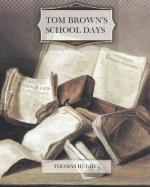The other side of the Manger is formed by the Dragon’s Hill, a curious little round self-confident fellow, thrown forward from the range, utterly unlike everything round him. On this hill some deliverer of mankind—St. George, the country folk used to tell me—killed a dragon. Whether it were St. George, I cannot say; but surely a dragon was killed there, for you may see the marks yet where his blood ran down, and more by token the place where it ran down is the easiest way up the hillside.
Passing along the Ridgeway to the west for about a mile, we come to a little clump of young beech and firs, with a growth of thorn and privet underwood. Here you may find nests of the strong down partridge and peewit, but take care that the keeper isn’t down upon you; and in the middle of it is an old cromlech, a huge flat stone raised on seven or eight others, and led up to by a path, with large single stones set up on each side. This is Wayland Smith’s cave, a place of classic fame now; but as Sir Walter has touched it, I may as well let it alone, and refer you to “Kenilworth” for the legend.
The thick, deep wood which you see in the hollow, about a mile off, surrounds Ashdown Park, built by Inigo Jones. Four broad alleys are cut through the wood from circumference to centre, and each leads to one face of the house. The mystery of the downs hangs about house and wood, as they stand there alone, so unlike all around, with the green slopes studded with great stones just about this part, stretching away on all sides. It was a wise Lord Craven, I think, who pitched his tent there.
Passing along the Ridgeway to the east, we soon come to cultivated land. The downs, strictly so called, are no more. Lincolnshire farmers have been imported, and the long, fresh slopes are sheep-walks no more, but grow famous turnips and barley. One of these improvers lives over there at the “Seven Barrows” farm, another mystery of the great downs. There are the barrows still, solemn and silent, like ships in the calm sea, the sepulchres of some sons of men. But of whom? It is three miles from the White Horse—too far for the slain of Ashdown to be buried there. Who shall say what heroes are waiting there? But we must get down into the Vale again, and so away by the Great Western Railway to town, for time and the printer’s devil press, and it is a terrible long and slippery descent, and a shocking bad road. At the bottom, however, there is a pleasant public; whereat we must really take a modest quencher, for the down air is provocative of thirst. So we pull up under an old oak which stands before the door.
“What is the name of your hill, landlord?”
“Blawing Stwun Hill, sir, to be sure.”
[Reader. “Stuym?”
Author: “Stone, stupid—the Blowing Stone.”]
“And of your house? I can’t make out the sign.”
“Blawing Stwun, sir,” says the landlord, pouring out his old ale from a Toby Philpot jug, with a melodious crash, into the long-necked glass.




